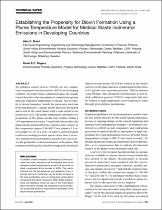 ResearchSpace
ResearchSpace
Establishing the propensity for dioxin formation using a plume temperature model for medical waste incinerator emissions in developing countries
JavaScript is disabled for your browser. Some features of this site may not work without it.
- ResearchSpace
- →
- Research Publications/Outputs
- →
- Journal Articles
- →
- View Item
| dc.contributor.author |
Brent, AC

|
|
| dc.contributor.author |
Rogers, DEC

|
|
| dc.date.accessioned | 2007-06-12T07:50:08Z | |
| dc.date.available | 2007-06-12T07:50:08Z | |
| dc.date.issued | 2002-07 | |
| dc.identifier.citation | Brent, AC and Rogers, DEC. 2002. Establishing the propensity for dioxin formation using a plume temperature model for medical waste incinerator emissions in developing countries. Journal of the Air and Waste Management Association, vol. 52(7), pp 811-821 | en |
| dc.identifier.issn | 1047-3289 | |
| dc.identifier.uri | http://hdl.handle.net/10204/586 | |
| dc.description | Copyright: 2002 Air and Waste Management Association | en |
| dc.description.abstract | Air pollution control devices (APCDs) are not compulsory for medical waste incinerators (MWIs) in developing countries. In South Africa, combustion gases are usually vented directly to the atmosphere at temperatures greater than the formation temperature of dioxin. The possibility of dioxin formation outside the incinerator stack has been hypothesized. A plume model has been developed and tested in the wind tunnel with a scale model of an incinerator stack. The plume temperature and trajectory predictions of the plume model were verified within a plus or minus 3% experimental accuracy. Using South African data, the plume model predicts that the residence time of gases in the temperature range of 150–450 ºC in a plume is 1.3 sec on average for 5% of a year (18 days) at meteorological conditions resulting in wind speeds of less than 1 m/sec. Two published dioxin formation models were used to assess the probability of dioxin formation in the plume. The formation models predict that the average polychlorinated dibenzodioxins/furans (PCDD/Fs) formed in the plume will exceed the stack emission regulations in South Africa of 0.2 ng/Nm3 toxic equivalent quotient (TEQ) by between 2 and 40 times. The calculated concentrations do not include additional gaseous PCDD/F compounds that may be formed at high-temperature post-combustion zones through pyrosynthesis mechanisms. | en |
| dc.language.iso | en | en |
| dc.publisher | Air and Waste Management Association | en |
| dc.subject | APCD | en |
| dc.subject | Air pollution control devices | en |
| dc.subject | MWI | en |
| dc.subject | Medical waste incinerators | en |
| dc.subject | Plume temperature models | en |
| dc.subject | Dioxin compounds formation | en |
| dc.subject | Developing countries | en |
| dc.subject | Atmospheric sciences | en |
| dc.title | Establishing the propensity for dioxin formation using a plume temperature model for medical waste incinerator emissions in developing countries | en |
| dc.type | Article | en |
| dc.identifier.apacitation | Brent, A., & Rogers, D. (2002). Establishing the propensity for dioxin formation using a plume temperature model for medical waste incinerator emissions in developing countries. http://hdl.handle.net/10204/586 | en_ZA |
| dc.identifier.chicagocitation | Brent, AC, and DEC Rogers "Establishing the propensity for dioxin formation using a plume temperature model for medical waste incinerator emissions in developing countries." (2002) http://hdl.handle.net/10204/586 | en_ZA |
| dc.identifier.vancouvercitation | Brent A, Rogers D. Establishing the propensity for dioxin formation using a plume temperature model for medical waste incinerator emissions in developing countries. 2002; http://hdl.handle.net/10204/586. | en_ZA |
| dc.identifier.ris | TY - Article AU - Brent, AC AU - Rogers, DEC AB - Air pollution control devices (APCDs) are not compulsory for medical waste incinerators (MWIs) in developing countries. In South Africa, combustion gases are usually vented directly to the atmosphere at temperatures greater than the formation temperature of dioxin. The possibility of dioxin formation outside the incinerator stack has been hypothesized. A plume model has been developed and tested in the wind tunnel with a scale model of an incinerator stack. The plume temperature and trajectory predictions of the plume model were verified within a plus or minus 3% experimental accuracy. Using South African data, the plume model predicts that the residence time of gases in the temperature range of 150–450 ºC in a plume is 1.3 sec on average for 5% of a year (18 days) at meteorological conditions resulting in wind speeds of less than 1 m/sec. Two published dioxin formation models were used to assess the probability of dioxin formation in the plume. The formation models predict that the average polychlorinated dibenzodioxins/furans (PCDD/Fs) formed in the plume will exceed the stack emission regulations in South Africa of 0.2 ng/Nm3 toxic equivalent quotient (TEQ) by between 2 and 40 times. The calculated concentrations do not include additional gaseous PCDD/F compounds that may be formed at high-temperature post-combustion zones through pyrosynthesis mechanisms. DA - 2002-07 DB - ResearchSpace DP - CSIR KW - APCD KW - Air pollution control devices KW - MWI KW - Medical waste incinerators KW - Plume temperature models KW - Dioxin compounds formation KW - Developing countries KW - Atmospheric sciences LK - https://researchspace.csir.co.za PY - 2002 SM - 1047-3289 T1 - Establishing the propensity for dioxin formation using a plume temperature model for medical waste incinerator emissions in developing countries TI - Establishing the propensity for dioxin formation using a plume temperature model for medical waste incinerator emissions in developing countries UR - http://hdl.handle.net/10204/586 ER - | en_ZA |





